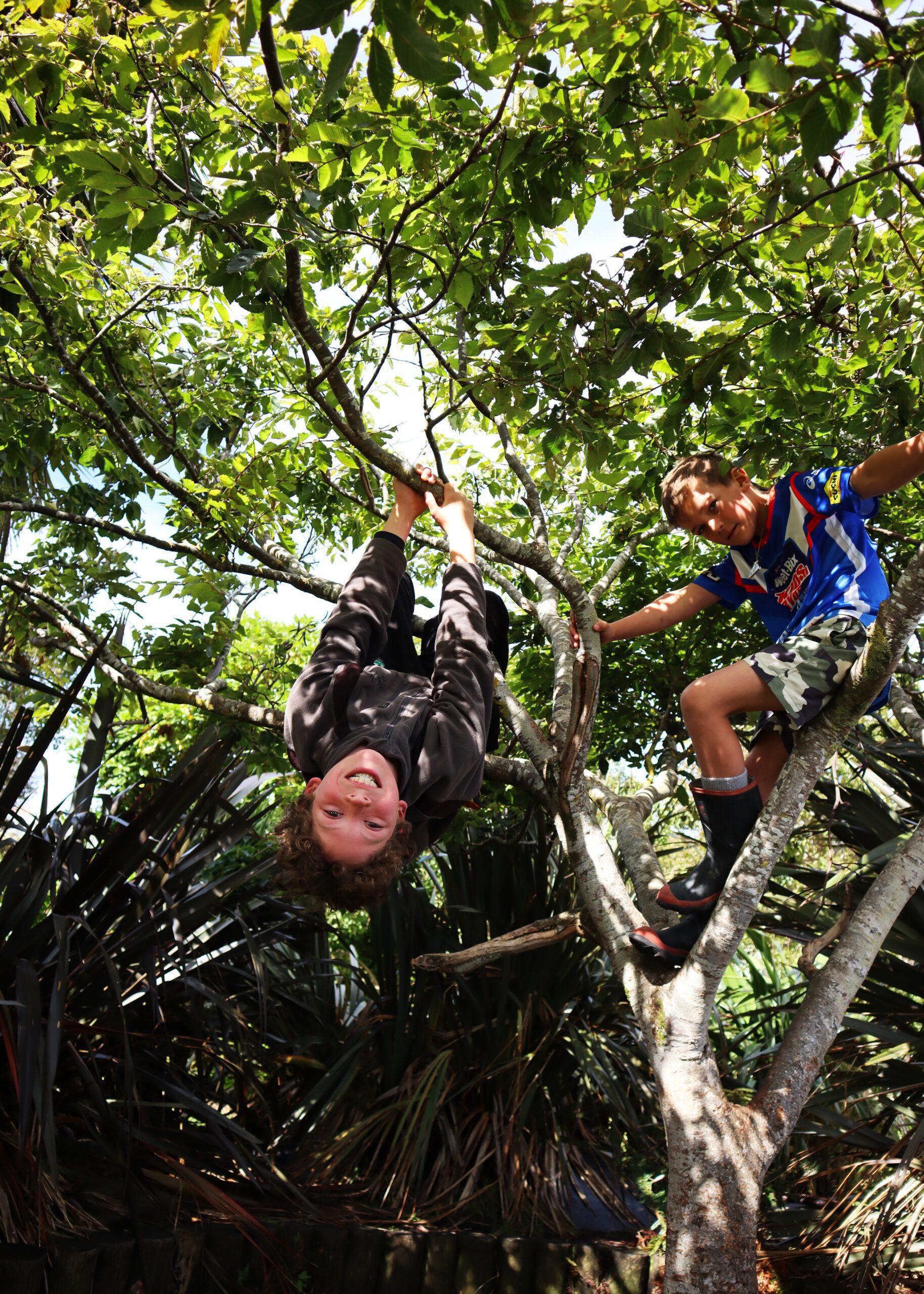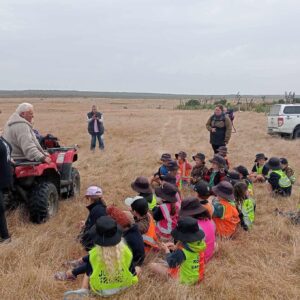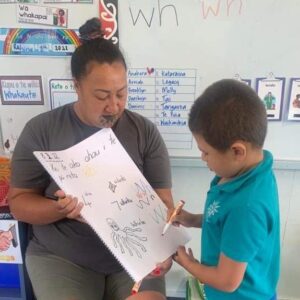At the country’s southernmost kura, a smiley-face flag snaps on a pole in the stiff Easterly off Foveaux Strait. The banner’s bright material is a perfect colour match — and perfectly incongruous – to yellow and black police tape wrapped around equipment on the school playground. What’s going on here? The ungrammatical IYKYK short answer: Because Stewart Island.
Te Kura o Rakiura/Halfmoon Bay School is situated directly across the road from the township’s main beach. It’s set back far enough inland that children can hear the song of bush birds: kākā and tūī clamour and call from branches outside the classroom windows. Yet the building is situated close enough to the sea to be visited by gulls and shorebirds. The shriek of blackbacks, the clang and metallic squeal of the freight boat unloading at the wharf – these sounds pierce the quiet of the whare pukapuka.
As the locals know well, the boundary between sea and land is blurred. Buoys hang from trees; dinghies decorate gardens; opalescent pāua shells mark pathways through the bush. If not for the gate installed to keep out nosy cruise shippers, the sea lions who visit the pub would surely galumph their way to the school’s doorstep. But fences can’t stop the oystercatchers! These stroppy shorebirds – particularly the pied ones — congregate on the school grounds. Every year, a pair builds their nest under the monkey bars. Up goes the yellow-and-black Do Not Cross police tape. The tamariki give these sharp-beaked parents a respectable berth until the eggs hatch.
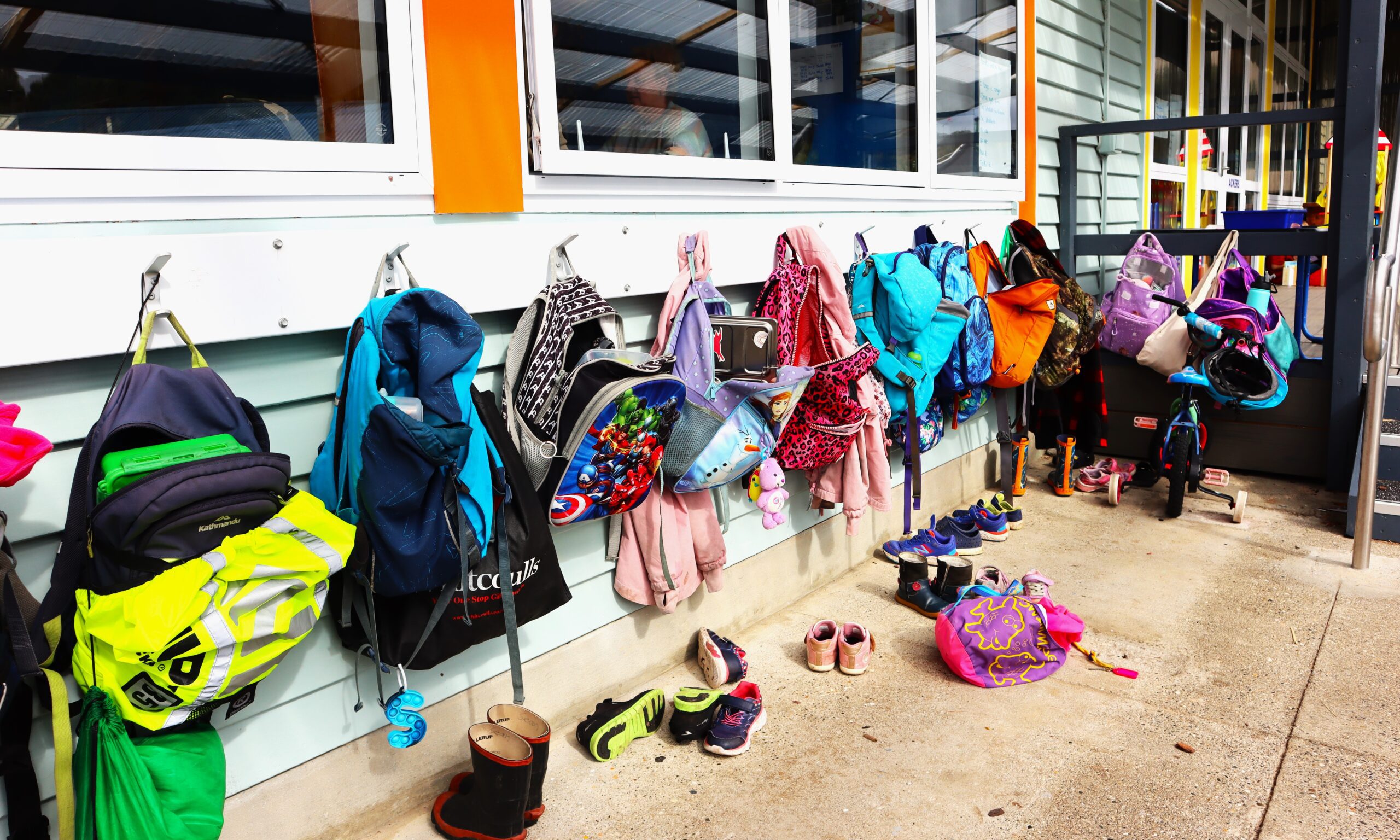
To reach Rakiura, one must cross the frisky stretch of water commonly known as Foveaux Strait – an hour sail from Bluff which can seem more carnival than ferry ride depending on the weather gods. A refrain from visitors goes something along these lines: “It’s so nice to spend time here away from the real world.” By this logic, when Stewart Island children visit the mainland, they are experiencing the real world and leaving behind some sort of faraway ferny dreamland. It’s a testament to how charming the place appears to visitors, and it also says something about the way off-islanders tend to perceive Rakiura: distant, isolated.
Stewart Islanders bristle at the term ‘isolated’. They don’t perceive the sea as a barrier. The school philosophy doesn’t subscribe to the notion of the island being separate from the world.
A student-drawn mural on the school wall includes a fabulous Zentangle whale. The school logo, painted at the main entrance of the kura and gracing school hoodies, features a whale. Whaling is a large part of Rakiura history (the marriage of whalers and Rakiura wāhine part of island genealogy). According to Māori pūrākau, Rakiura was once connected to the South Island by an isthmus. Kiwa, a navigator tired of paddling his waka around it, asked Kewa the whale to chew through it. Kewa went to lunch and munch, munch, munch – Te Ara o Kiwa/ the Pathway of Kiwa was formed. (This story was re-told recently by a student using computer coding to create a terra-snacking-Kewa video game.)
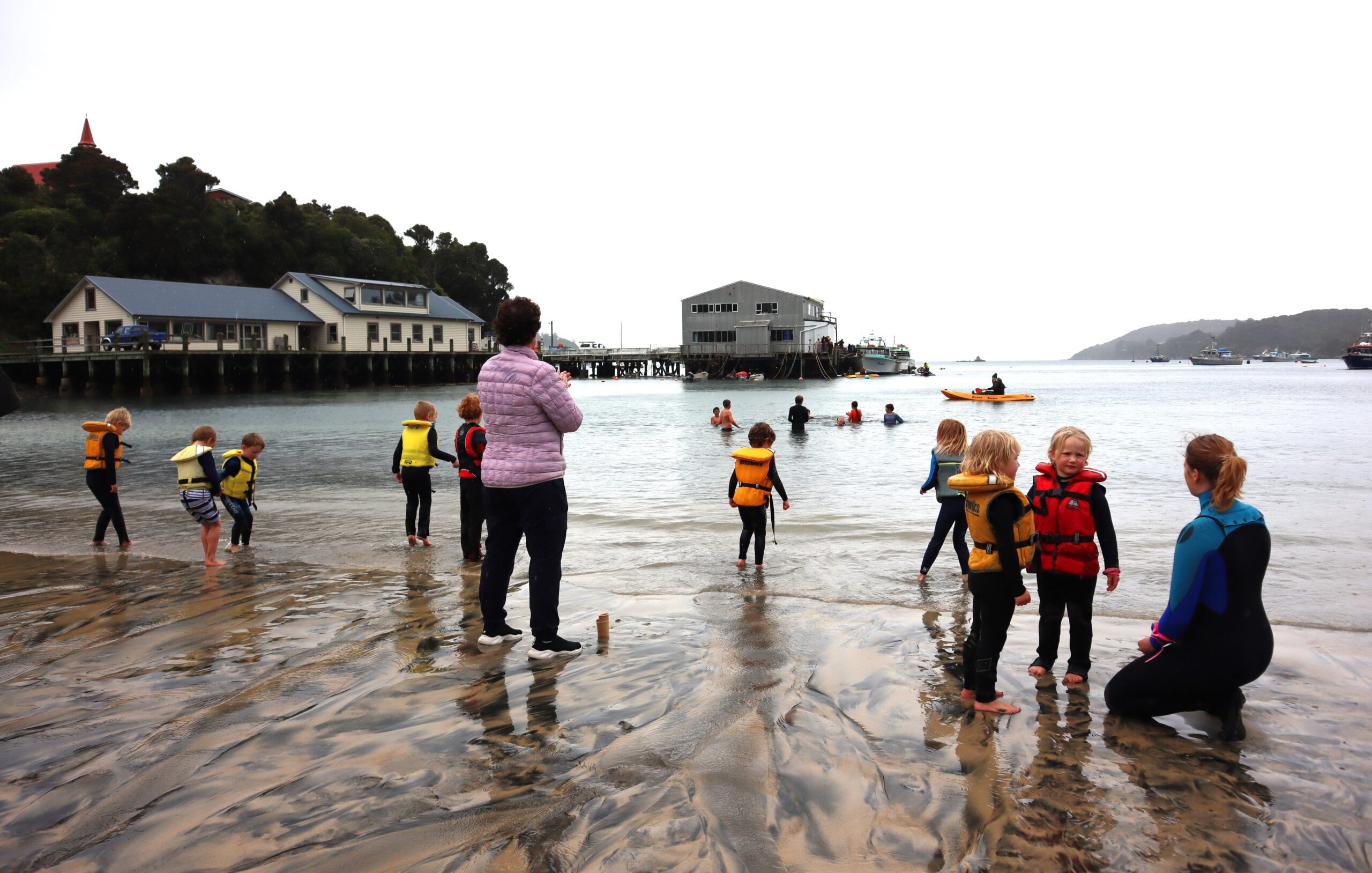
Playground, workplace, garden, sports arena, pantry, artistic inspiration … the sea is many things. For the school it is all this and also, always, Te Ara. The term pathway used in the broadest sense: channels of learning and adventure leading to and from Rakiura. The school vision embraces infinite possible ara.
The notion of moulding a young person to fit the confines of a city centre cubicle seems absurdly out-of-touch – particularly from an island perspective, particularly in this post-lockdown world.
The children’s education is taken seriously: yes to the three Rs. But just as loudly, yes to mana and character; yes to bush and sea skill; a resounding āe to te reo and te ao. Principal and teacher Kath Johnson has been a passionate student and advocate of learning Te Reo, and ensures it is used daily in the classroom. The school seeks to offer every student the best possible learning experience: “With a broad curriculum and making sure that kids who find academic subjects more challenging still have lots of opportunities to excel in their areas of strength,” says Johnson. “We also try to focus on teaching methods that cater better for neuro-diverse students such as structured literacy, Alpha to Omega, Numicon, speech lessons, hands-on, experiential-type learning experiences and limiting technology in the junior school.”

The school certainly celebrates experiential-type learning: the Survival Swim and Bush School are two prime examples. In February, to the shock of onlooking tourists, pyjama-clad children jump from the Halfmoon Bay Wharf into the bracing Southern Ocean, making their way to the shore to complete the sea survival swim. Every week, the junior students attend Bush School – an outdoor patch of forest where they spend their morning making punga huts, getting impressively muddy, building fires, cooking damper, and learning bush skills from parent experts in the field.
Johnson, in her seventeenth year on the job, looks for any opportunity for the kids to have an educational experience. If it’s occurring on the mainland, so be it. The kids are familiar with the early morning journey to Bluff, the rushed corral to the back deck, parent helpers barking orders while disembarking; lightning-quick loo stop at the ferry terminal; car seat sort-out, then a convoy of cars conveying them north. When you see a Stewart Island kid competing at Kid Lit, or Southland Swim or a track event, they have likely just jumped out of a car and sprinted to the start after navigating a dawn awakening, hour-long ferry ride and the winding Bluff Road. They don’t mind – the students have never known it any other way. In the past several years, HMB School has dominated mainland comps, garnering medals in triathlons, swim meets, science and social science fairs, adventure and orienteering races, and track events. It doesn’t hurt that their training grounds include the Rakiura Track – Year 8s are allowed to compete in the annual Rakiura Challenge, a hilly 32-km mud-bath. Last year a HMB student completed the race in 3.5 hours placing 27th out of 230 runners! While this year, a student placed first at the Southland Cross Country in Waimumu.
When you see a Stewart Island kid competing at Kid Lit, or Southland Swim or a track event, they have likely just jumped out of a car and sprinted to the start after navigating a dawn awakening, hour-long ferry ride and the winding Bluff Road.
The achievements happen at home too. The school created Tiakina Te Wharawhara, a film about the importance of protecting Ulva Island (opening night was a red-carpet affair). Students assist the Yellow-eyed Penguin rehabilitation program, releasing the chicks back into the wild. This activity isn’t just a cute photo op – HMB School students are involved, year-round, in protecting and celebrating the taonga of Rakiura, and these tasks are not always as fun as cute selfies with chicks. These kids put their mana where their mouth is. Every week, rain or shine but usually rain, a group treks out toward Acker’s Point lighthouse for the unglamourous task of changing the batteries and memory sticks on trail cams. Back at school, they study the footage and note the presence of rats among the kiwi and penguins. This further inspires the school’s ongoing participation in the community rat trapping network. They (in)famously lead a rat trapping comp which includes prizes for “biggest teeth” and “best fur coat.” The unglamorous work continues with a student initiative to grind fish frames and guts into fertilizer to sell as a fundraiser for the school.
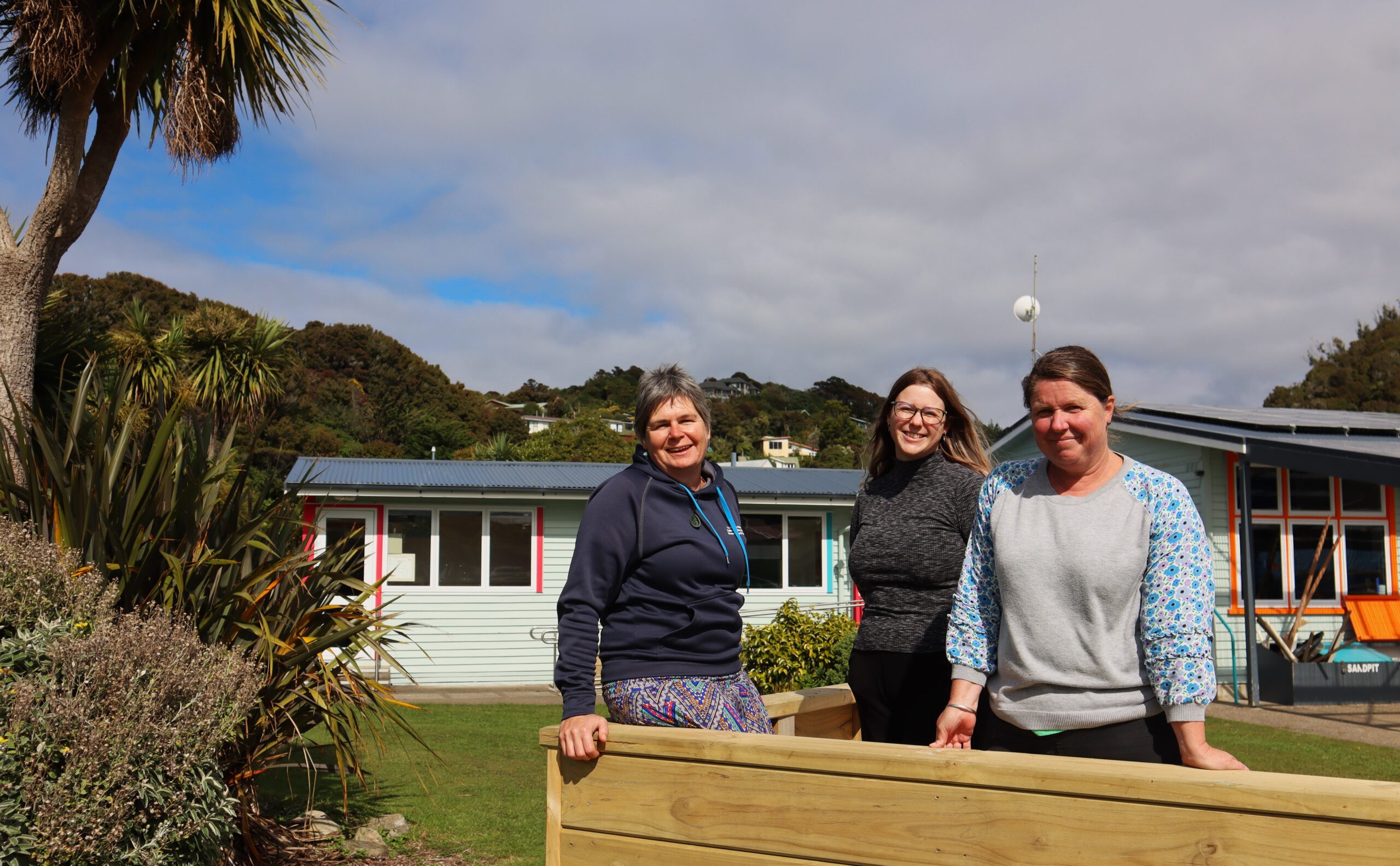
The school’s three teachers are excellent educators who support each other – it couldn’t work any other way in such a small school. Te Kura o Rakiura also mines the island community for expertise, guidance and inspiration. Helping hands are never hard to find.
“We get a lot more attention and opportunities and people are always willing to bend over backwards to help us out,” says Johnson.
The art teacher is a professional artist who volunteers his time. The owner of the garage spends his early mornings teaching the kids to swim. Parents volunteer to coach various sports, and head after-school clubs. Scientists from the Department of Conservation visit regularly. The children are well acquainted with Gadget – a rodent detecting dog. Parents who are former restaurateurs hold sea-to-table cooking classes at the school, complementing the school’s garden-to-table program. A fisherman – married to one of the teachers – has shared freshly caught kai moana for the kids to see and taste, including oysters. Last year, he brought a 162-cm tuna to the playground for the tamariki to inspect before sampling fresh sashimi. Tourists peering onto school grounds from behind the gate would have wondered at the sight of a 60-kg fish hanging from the swing-set. Another Because Stewart Island moment.
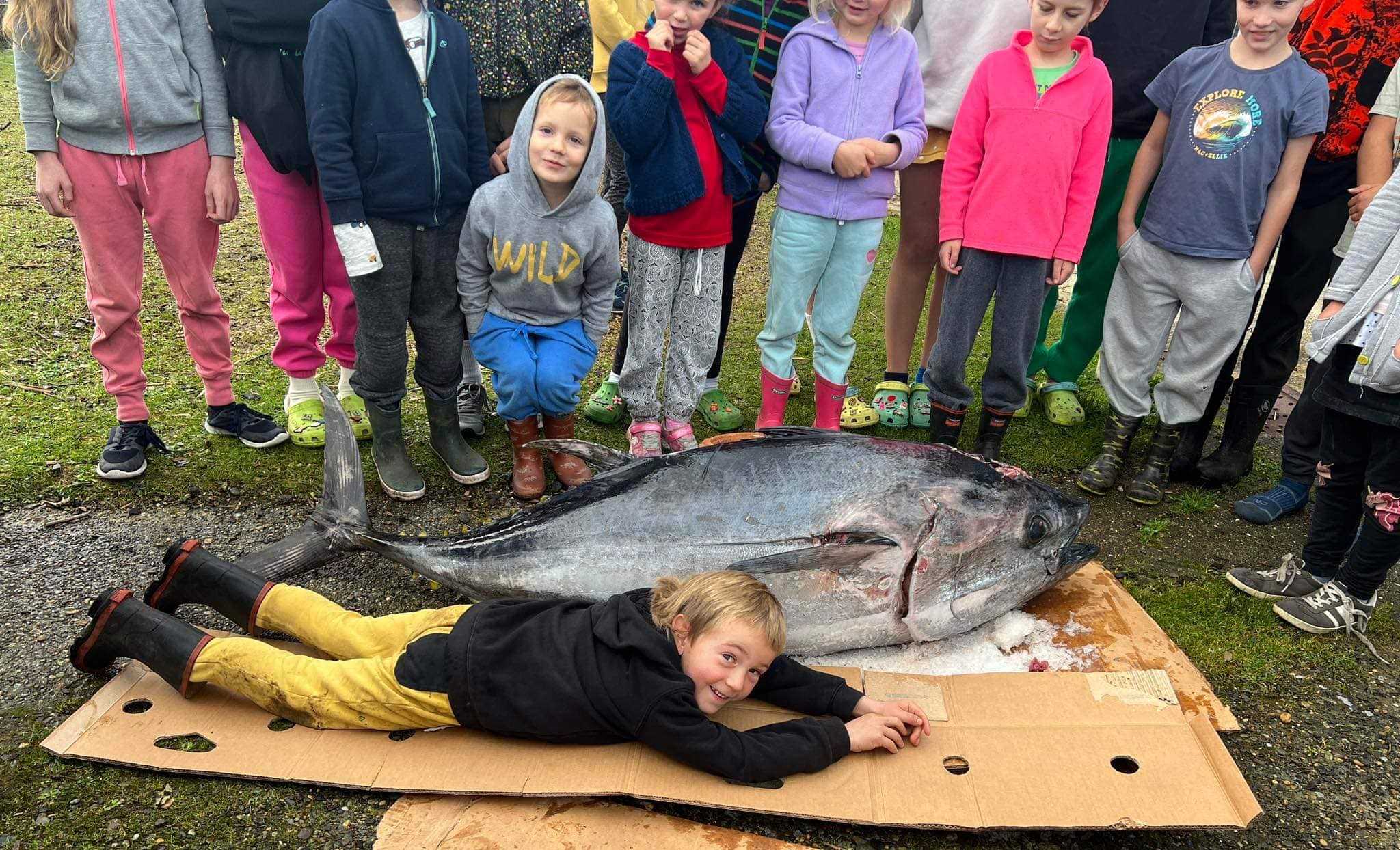
For all the clamour and hustle-bustle of these outdoor pursuits, the school is rife with keen wordsmiths and bookworms. This year, a student placed first in the Queenstown writers’ comp. The tiny school sends two teams to compete in the national Kid Lit Quiz. Recently, one of the teams placed second out of 36. Competition is hot to be a part of this elite squad of bibliophiles who spend hours after school studying classics, poetry, and mythology. One year, the school librarian challenged the kids to memorize some of Lewis Carroll’s Jabberwocky. Most of the kids recited stanzas and one young girl performed the entire thing. Twas brillig and brilliant…
Mind you, these same kids can swim from the wharf, perform a haka, cook pāua, Zentangle a whale, build a rat trap, and code a video game. Attending a so-called isolated school hasn’t impacted the students a fig. The curriculum doesn’t sacrifice academics for bush skills, or sea smarts for culture. Rather, these Rakiura Renaissance boys and girls can do it all.
“We surprise everyone with our achievements, they don’t expect a bunch of kids from a tiny school on an Island at the bottom of the world to be so ‘awesome’,” says Johnson.
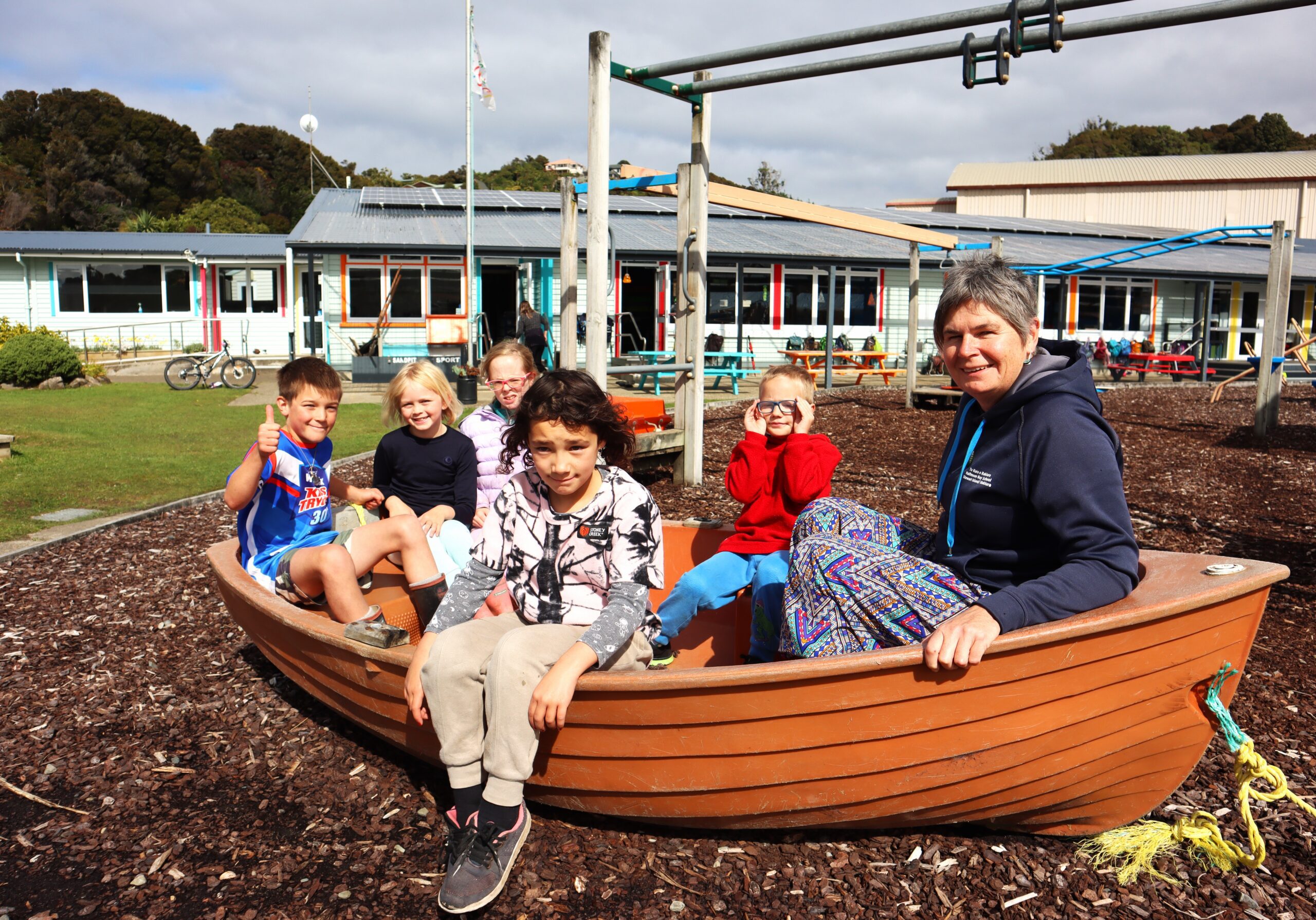
This year Te Kura o Rakiura Halfmoon Bay School celebrates its 150-year Jubilee. In all that time, everything and nothing has changed. The world has leapt forward with technology that connects Rakiura to the rest of the world: more efficient travel across the Strait; Zooms and Zuis.
And yet: so much, so beautifully, remains the same. Bare feet and year-round shorts are the school uniform of these weather-tough island tamariki. Just as the students of a century yore walked through the bush to get to school and learned to swim in the sea, the children today are bonded with Te Taiao. The attitude isn’t let’s make this school succeed despite our location; rather, this school slays because of where we are. Because Stewart Island.
Rakiura Stewart Island stats
Human pop. 400
Kiwi pop. 20,000
1 school
1 pub
Kura stats
# students: 40 (approx. 50% Māori; 25% Rakiura Māori)
# teachers: 3
# classrooms: 3
Green Gold Enviroschool
Environment Southland Councillors’ Award 2023
